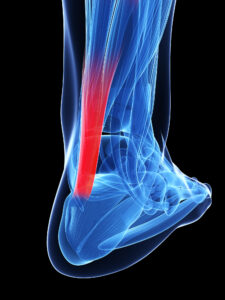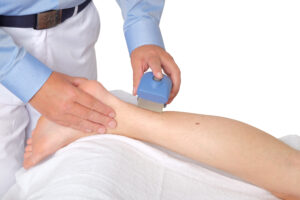🎥 Chapters
00:00 Understanding Tendinitis
0:24 Piezowave Shockwave Therapy for Tendinopathy, Tendonitis of Achilles, Rotator Cuff, Patellar Tendon & More
2:07 Tendonitis versus Tendinopathy: What’s the Difference?
2:36 Extracorporeal Shockwave Therapy Explained: Regenerate Your Tendons
4:17 Extracorporeal Shockwave Therapy for Tendinopathy
4:51 Research Backed Results: Studies on Neovascularization and Regeneration for Achilles Tendon
5:24 Research on Shockwave Therapy and its Benefit for Tendinopathy
Tendinopathy and Shockwave Therapy
Extracorporeal Shockwave Therapy (ESWT) has emerged as the number one modality for helping tendinopathies. Tendons are the thick, fibrous cords that attach muscles to bones. The two most common types of tendinopathy are tendinitis (inflammation of the tendon) and tendinosis (degeneration of the tendon without significant inflammation) and shockwave therapy is the number one choice for helping tendons heal.

Achilles tendon helped with Shockwave Therapy
How Does a Tendinopathy Happen?
- Overuse: Repetitive motion or excessive load on the tendon can lead to micro-tears and degeneration. This is common in athletes and individuals whose occupations involve repetitive movements. Here the adhesions that causes unnecessary tendon thickening can be broken up with shockwave therapy. New collagen fibers will replace the disorganized scar tissue that alters mechanics and causes pain.
- Age-Related Changes: As people age, tendons lose elasticity and become more prone to injury and degeneration. Shockwave therapy is a great option for seniors who want to get back to activities like tennis, golf, hiking and swimming without the burden of tendinitis or tendinosis.
- Biomechanics: Poor posture, improper technique in sports or activities, and muscle imbalances can increase stress on tendons. This is where a wholistic approach is key. Looking into breathing mechanics and dynamic posture considerations is key to take unwanted stresses off of your tendons.
- Acute Injury: A sudden, severe injury to the tendon can lead to tendinopathy. Low energy focused shockwaves can be used in the acute phase. Some people would see this a counterintuitive as the adhesions haven’t yet formed. However, ESWT is even used for wound healing and immediately post surgically for better healing. So, whether the injury is 30 yeas old or 30 minutes old, come in and let’s work through the healing process with ESWT.
- Medical Conditions: Certain conditions, such as diabetes and rheumatoid arthritis, can predispose people to tendon problems. Low-energy focused shockwave therapy, like the machine we use in our office, is still an option but we would discourage the use of radial shockwave. Radial shockwave can bruise, scab and even damage the area. It is a different wave and the wave is not focused.
How does shockwave therapy help heal tendons?
In the cases of chronic inflammation, adhesions and degenerative changes in tendons, shockwave therapy will crank back time in the tissue. The shockwaves penetrate the skin and soft tissues, tendon at precise depths. Upon reaching the targeted area, the shockwaves trigger a cascade of biological responses. There is a breaking up of brittle calcifications, increased blood flow or neovascularization, a recruitment of healing factors and stimulation of tissue regeneration with new collagen formation. This process facilitates the repair of damaged tendons and promotes the resolution of inflammation. This, ultimately, leads to pain relief and improved function. The studies even show that ESWT will help prevent future injuries.
Common tendonopathies helped with ESWT
One of the key tendons benefiting from ESWT is the achilles tendon, a crucial structure connecting your calf muscles to the heel bone. In cases of achilles tendinopathy, or achilles tendonitis, there is pain and stiffness in the back of the ankle. ESWT has shown effectiveness in promoting tissue regeneration and reducing the pain of achilles tendinitis. By delivering focused shockwaves to the affected area, ESWT triggers a mild inflammatory response, prompting the body to initiate the repair process and accelerate healing of the damaged tendon.
Similarly, ESWT has demonstrated efficacy in treating patellar tendinopathy, commonly known as jumper’s knee, which affects the tendon connecting the patella (kneecap) to the shinbone. Athletes and people engaged in repetitive jumping or running activities often experience patellar tendinopathy, characterized by pain just below the kneecap. ESWT leads to improved tendon structure and function, ultimately alleviating pain and restoring mobility.
Rotator cuff tendinopathy, involving the tendons and muscles surrounding the shoulder joint, is another condition that can benefit from ESWT intervention. Tendons such as the supraspinatus, infraspinatus, and subscapularis are commonly affected in rotator cuff tendinopathy, resulting in shoulder pain, weakness, and limited range of motion. ESWT targets the affected tendons with high-energy shockwaves, promoting neovascularization and the formation of new tendon tissue. This enhanced blood flow and tissue regeneration contribute to pain reduction and improved function in individuals suffering from rotator cuff tendinopathy.
ESWT offers a non-invasive and effective treatment option for tennis elbow by delivering shockwaves to the extensor carpi radialis brevis tendon. Here, tissue healing and pain reduction is achieved. Through its regenerative effects on tendon tissue, ESWT helps alleviate symptoms and improve functional outcomes in individuals with lateral epicondylitis. This is the case even when the tennis elbow has been there for years.
Cortisone injection versus shockwave therapy for tendinitis and tendionsis?
The lion’s share of the problem is that the tendons are in a state of deterioration rather than inflammation. This points to the correct therapy. Corticosteroid injections work by breaking down the tissue even further. This takes pressure off of some of the challenged tissue but, also, thins the tissue. The benefit is temporary pain relief but the downside is a weaker tendon as well as the surrounding ligaments and bone. With extracorporeal shockwave therapy (ESWT) low-energy focused acoustic waves or shockwaves are applied to precise depths into the involved tendon. Firstly, this can break up brittle adhesions that are decreasing flexibility in the tendon. Secondly, angiogenesis, or new blood vessels proliferation, is stimulated. This allows for growth factors to be delivered to the area and, finally, new collaged to grow. Yes, you heard that correctly. The Piezowave low energy focused shockwave therapy targets the root cause of damaged tendons by promoting tissue regeneration and resolving chronic inflammation directly at the source. So, there is not just pain relief but a stronger tendon. This translates to more confidence when running, lifting, throwing, swimming and more.
In conclusion, ESWT holds promise as a valuable intervention for various tendinopathies affecting tendons such as the Achilles, patellar, rotator cuff, and extensor carpi radialis brevis. By stimulating tissue regeneration, promoting neovascularization, and reducing pain, ESWT offers a non-invasive approach to managing tendon conditions and restoring function in affected individuals.
Dr Adam Fields is a practicing chiropractor in the Bay Area in Northern California and helps people daily in his office with many challenges that can be helped by shockwave therapy from tendinopathies, arthritis, cartilage regeneration, post surgical scar tissue, pelvic pain, altered biomechanics and more. He uses Endonasal Cranial Adjusting, the Muncie Technique, Extracorporeal Shockwave Therapy (ESWT), Class IV Laser Therapy, posture correction, lifestyle modification, muscle work, and other techniques to help his patients.
You can reach Dr Fields for in-person (Los Gatos and San Jose, California) or telehealth appointments here.
Shockwave Therapy and Tendinopathy Research
Zyluk, A., & Mosiejczuk, H. (2020). Outcomes of the treatment of trigger digits by extracorporeal shock wave therapy (ESWT). Journal of Hand Surgery (European Volume), 45(4), 370-375. https://doi.org/10.1177/1753193419895723
Wang, C. J., Wang, F. S., Yang, K. D., Weng, L. H., Hsu, C. C., Huang, C. S., & Yang, L. C. (2003). Shock wave therapy induces neovascularization at the tendon-bone junction. A study in rabbits. Journal of Orthopaedic Research, 21(6), 984-989. https://doi.org/10.1016/S0736-0266(03)00104-9
Wang, C. J., Ko, J. Y., Chan, Y. S., Weng, L. H., & Hsu, S. L. (2007). Extracorporeal shockwave for chronic patellar tendinopathy. The American Journal of Sports Medicine, 35(6), 972-978. https://doi.org/10.1177/0363546507299705
Schroeder, A. N., Tenforde, A. S., & Jelsing, E. J. (2020). Extracorporeal shockwave therapy in the management of sports medicine injuries. Current Sports Medicine Reports, 19(4), 161-167. https://doi.org/10.1249/JSR.0000000000000726
Mani-Babu, S., Morrissey, D., Waugh, C., Screen, H., & Barton, C. (2015). The effectiveness of extracorporeal shock wave therapy in lower limb tendinopathy: a systematic review. The American Journal of Sports Medicine, 43(3), 752-761. https://doi.org/10.1177/0363546514531915

